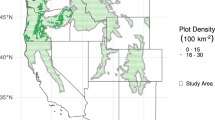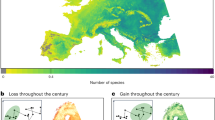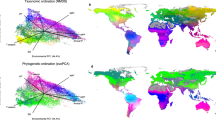Abstract
As climate warms, trees are expected to track their ideal climate, referred to as ‘range shifts’; however, lags in tree range shifts are currently common. Disturbance events that kill trees may help catalyse tree migrations by removing biotic competition, but can also limit regeneration by eliminating seed sources, and it is unknown whether disturbance will facilitate or inhibit tree migrations in the face of climate change. Here we use national forest inventory data to show that seedlings of 15 dominant tree species in the interior western United States occupy historically cooler areas than mature trees, as expected with climate warming. However, the climatic differences between adults and seedlings are the result of widespread regeneration failures in the hottest portions of species’ ranges. Disturbances did not uniformly catalyse climatic range shifts; differences were species- and disturbance-specific. Assisted migration programmes may thus be needed to help trees adapt their ranges to climate change.
This is a preview of subscription content, access via your institution
Access options
Access Nature and 54 other Nature Portfolio journals
Get Nature+, our best-value online-access subscription
27,99 € / 30 days
cancel any time
Subscribe to this journal
Receive 12 print issues and online access
209,00 € per year
only 17,42 € per issue
Buy this article
- Purchase on SpringerLink
- Instant access to full article PDF
Prices may be subject to local taxes which are calculated during checkout



Similar content being viewed by others
Data availability
The derived data that support the findings of this study are available via Figshare at https://doi.org/10.6084/m9.figshare.27146415 (ref. 43). The exact coordinates (latitude and longitude) for FIA plots were used in this study under a Memorandum of Understanding agreement with the USDA Forest Service FIA programme. However, FIA locations are protected by law so that they and the data extracted from them cannot be shared publicly. The FIA data that support the findings of this study are available from the FIA DataMart, https://apps.fs.usda.gov/fia/datamart/datamart.html. The LANDFIRE Vegetation Disturbance data that support the findings of this study are available from the LANDFIRE programme, https://landfire.gov/disturbance. The MTBS burned areas boundaries dataset that supports the findings of this study is available from the MTBS programme, https://www.mtbs.gov/direct-download. The ClimateWNA data that supports the findings of this study are available from A. Hamann’s website, https://sites.ualberta.ca/~ahamann/data/climatewna.html.
Code availability
The code used to produce the findings of this study is available in Code Ocean (https://doi.org/10.24433/CO.3024024.v1).
References
Renwick, K. M. & Rocca, M. E. Temporal context affects the observed rate of climate-driven range shifts in tree species. Glob. Ecol. Biogeogr. 24, 44–51 (2015).
Lenoir, J. & Svenning, J.-C. Climate-related range shifts—a global multidimensional synthesis and new research directions. Ecography 38, 15–28 (2015).
Sharma, S. et al. North American tree migration paced by climate in the West, lagging in the East. Proc. Natl Acad. Sci. USA 119, e2116691118 (2022).
De Frenne, P. et al. Microclimate moderates plant responses to macroclimate warming. Proc. Natl Acad. Sci. USA 110, 18561–18565 (2013).
Landhäusser, S. M., Deshaies, D. & Lieffers, V. J. Disturbance facilitates rapid range expansion of aspen into higher elevations of the Rocky Mountains under a warming climate. J. Biogeogr. 37, 68–76 (2010).
Stevens-Rumann, C. S. et al. Evidence for declining forest resilience to wildfires under climate change. Ecol. Lett. 21, 243–252 (2018).
Johnstone, J. F. et al. Changing disturbance regimes, ecological memory, and forest resilience. Front Ecol. Environ. 14, 369–378 (2016).
Nigro, K. M., Rocca, M. E., Battaglia, M. A., Coop, J. D. & Redmond, M. D. Wildfire catalyzes upward range expansion of trembling aspen in southern Rocky Mountain beetle-killed forests. J. Biogeogr. 49, 201–214 (2022).
Atkins, J. W. et al. Application of multidimensional structural characterization to detect and describe moderate forest disturbance. Ecosphere 11, e03156 (2020).
Stevens-Rumann, C., Morgan, P. & Hoffman, C. Bark beetles and wildfires: how does forest recovery change with repeated disturbances in mixed conifer forests? Ecosphere 6, art100 (2015).
Renwick, K. M., Rocca, M. E. & Stohlgren, T. J. Biotic disturbance facilitates range shift at the trailing but not the leading edge of lodgepole pine’s altitudinal distribution. J. Veg. Sci. 27, 780–788 (2016).
Hill, A. P. & Field, C. B. Forest fires and climate-induced tree range shifts in the western US. Nat. Commun. 12, 6583 (2021).
Stevens-Rumann, C. S. & Morgan, P. Tree regeneration following wildfires in the western US: a review. Fire Ecol. 15, 15 (2019).
Coop, J. D. et al. Wildfire-driven forest conversion in Western North American landscapes. BioScience 70, 659–673 (2020).
Young, D. J. N. et al. Post-fire forest regeneration shows limited climate tracking and potential for drought-induced type conversion. Ecology 100, e02571 (2019).
Vellend, M. et al. Plant responses to climate change and an elevational gradient in Mont Mégantic National Park, Québec, Canada. Northeast. Nat. 28, 4–28 (2021).
Brusca, R. C. et al. Dramatic response to climate change in the Southwest: Robert Whittaker’s 1963 Arizona mountain plant transect revisited. Ecol. Evol. 3, 3307–3319 (2013).
Kroiss, S. J. & HilleRisLambers, J. Recruitment limitation of long-lived conifers: implications for climate change responses. Ecology 96, 1286–1297 (2015).
Andrus, R. A., Harvey, B. J., Rodman, K. C., Hart, S. J. & Veblen, T. T. Moisture availability limits subalpine tree establishment. Ecology 99, 567–575 (2018).
Burrill, E. A. et al. The Forest Inventory and Analysis Database:Database Description and User Guide for Phase 2 (version 9.1) (USDA Forest Service, 2021).
Zhu, K., Woodall, C. W. & Clark, J. S. Failure to migrate: lack of tree range expansion in response to climate change. Glob. Change Biol. 18, 1042–1052 (2012).
Rocca, M. E., Brown, P. M., MacDonald, L. H. & Carrico, C. M. Climate change impacts on fire regimes and key ecosystem services in Rocky Mountain forests. For. Ecol. Manag. 327, 290–305 (2014).
Harvey, B. J., Donato, D. C., Romme, W. H. & Turner, M. G. Fire severity and tree regeneration following bark beetle outbreaks: the role of outbreak stage and burning conditions. Ecol. Appl. 24, 1608–1625 (2014).
Higuera, P. E. & Abatzoglou, J. T. Record-setting climate enabled the extraordinary 2020 fire season in the western United States. Glob. Change Biol. 27, 1–2 (2021).
Crockett, J. L. & Hurteau, M. D. Post-fire early successional vegetation buffers surface microclimate and increases survival of planted conifer seedlings in the southwestern United States. Can. J. For. Res. 52, 416–425 (2022).
Williams, A. P. et al. Large contribution from anthropogenic warming to an emerging North American megadrought. Science 368, 314–318 (2020).
Jactel, H. et al. Drought effects on damage by forest insects and pathogens: a meta-analysis. Glob. Change Biol. 18, 267–276 (2012).
Davis, K. T. et al. Wildfires and climate change push low-elevation forests across a critical climate threshold for tree regeneration. Proc. Natl Acad. Sci. USA 116, 6193–6198 (2019).
Butt, N. et al. Importance of species translocations under rapid climate change. Conserv. Biol. 35, 775–783 (2021).
Rehfeldt, G. E. et al. Comparative genetic responses to climate in the varieties of Pinus ponderosa and Pseudotsuga menziesii: reforestation. For. Ecol. Manag. 324, 147–157 (2014).
Bechtold, W. A. & Patterson, P. L. The Enhanced Forest Inventory and Analysis Program—National Sampling Design and Estimation Procedures (USDA Forest Service, 2005).
Hamann, A., Wang, T., Spittlehouse, D. L. & Murdock, T. Q. A comprehensive, high-resolution database of historical and projected climate surfaces for western North America. Bull. Am. Meteorol. Soc. 94, 1307–1309 (2013).
McCune, B., Grace, J. B. & Urban, D. L. Analysis of Ecological Communities (MjM software design, 2002).
R Core Team. R: A Language and Environment for Statistical Computing. http://www.R-project.org/ (R Foundation for Statistical Computing, 2022).
Vegetation Disturbance. LF 2014 (LANDFIRE, 2016).
MTBS Perimeters 1984–2016 (MTBS, 2018).
Schapira, Z. H., Stevens-Rumann, C. S. & Shorrock, D. Subalpine tree seedlings: assessing aging methodology and drivers of establishment. For. Ecol. Manag. 497, 119516 (2021).
Jackson, A. L., Inger, R., Parnell, A. C. & Bearhop, S. Comparing isotopic niche widths among and within communities: SIBER—stable isotope Bayesian ellipses in R. J. Anim. Ecol. 80, 595–602 (2011).
Plummer, M., Stukalov, A. & Denwood, M. rjags: Bayesian graphical models using MCMC. R package version 4.14 https://doi.org/10.32614/CRAN.package.rjags (2022).
Jackson, A. L., Parnell, A. SIBER: Stable Isotope Bayesian Ellipses in R. R version 2.1.9 https://doi.org/10.32614/CRAN.package.SIBER (2023).
Hobbs, N. T. & Hooten, M. B. Bayesian Models: A Statistical Primer for Ecologists (Princeton Univ. Press, 2015).
Petitpierre, B. et al. Climatic niche shifts are rare among terrestrial plant invaders. Science 335, 1344–1348 (2012).
Nigro, K. M., Pelz, K., Rocca, M. E. & Redmond, M. D. Trailing edge contractions are common in interior western US trees under varying disturbances. figshare https://doi.org/10.6084/m9.figshare.27146415 (2024).
Acknowledgements
This project was funded by a National Science Foundation Graduate Research Fellowship to K.M.N. under grant no. 006784 and a Colorado State University Warner College of Natural Resources McIntire-Stennis grant (M.D.R. and K.M.N). Any opinions, findings and conclusions or recommendations expressed in this material are those of the authors and do not necessarily reflect the views of the National Science Foundation. The USDA Forest Service, FIA programme collected the data used in this study.
Author information
Authors and Affiliations
Contributions
K.M.N. and M.D.R. conceived the idea and designed the study. K.M.N. analysed the data and wrote the initial draft. K.M.N., M.D.R., K.P. and M.E.R. contributed substantially to editing the paper and providing feedback on analyses.
Corresponding author
Ethics declarations
Competing interests
The authors declare no competing interests.
Peer review
Peer review information
Nature Climate Change thanks Avery Hill and the other, anonymous, reviewer(s) for their contribution to the peer review of this work.
Additional information
Publisher’s note Springer Nature remains neutral with regard to jurisdictional claims in published maps and institutional affiliations.
Extended data
Extended Data Fig. 1 Biplot of principal components analysis axes 1 and 2.
PC1 explained 74.4% of the variance in climate variables and PC2 explained 16.09% of the variance. Climate variables are overlaid as red vectors on the plot indicating which climate variables are most correlated with which PC. Gray dots are plot scores for each FIA plot in the analysis (n = 25,030). Labelled dotted lines indicate the climate associated with each of the cardinal and ordinal directions on the plot.
Extended Data Fig. 2 Comparison of seedling and adult 95% prediction ellipses (climatic ranges) in PCA space for each species between disturbance types.
Adult ellipses are solid lines and seedling ellipses are dashed.
Extended Data Fig. 3 Shift type occurrence across disturbance types and examples.
a) The number of species for each disturbance type that experienced each shift type (different colors) on PC1. b) Examples of each type of PC1 shift. Circular points represent FIA plots containing either the adult (black) or seedling (color) of the species in climate space. Diamond points represent the centroid for both the adult and seedling climatic range of each species while ellipses show the 95% credible intervals around adult (black) and seedling (color) distributions. Insets visually depict shift types were lines represent the climatic-range margins on PC1 and arrows show the direction of difference from adult to seedling.
Extended Data Fig. 4 Estimate and 95% credible interval of the difference between seedling and adult climatic-range margins and centroids, relativized by adult climatic-range width on PC2, for each disturbance type per species.
Estimates and credible intervals were calculated from the 4,000 derived posterior estimates of range margin position for each species in each disturbance type. Climatic range margins were modeled using the sample sizes displayed in Extended Data Table 2. Species points are ordered according to the mean PC1 value of plots with adults present, which ranges from hot/dry to cool/wet climates. Points significantly different from zero are outlined in black with black credible intervals and points of nonsignificant differences are gray. A significant positive estimate indicates that the seedling distribution is colder/drier than the conspecific adult distribution, whereas a negative value indicates that seedlings distributions were hotter/wetter. Species by disturbance combinations are shaded by shift type if applicable.
Extended Data Fig. 5 Distance between adult and seedling centroids for each species in each disturbance type.
Points show mean distance between centroids and error bars show 95% credible intervals, calculated from 4,000 posterior estimates. Centroids were modeled using sample sizes displayed in Extended Data Table 2. Non-overlapping credible intervals are considered to represent significant differences in distance and are denoted by differing letters where applicable.
Extended Data Fig. 6 Estimate and 95% credible interval of the difference between seedling and adult climatic-range margins and centroids, relativized by adult climatic-range width on each climate variable, for each disturbance type per species.
Estimates and credible intervals were calculated from the 4,000 derived posterior estimates of range margin position for each species in each disturbance type. Climatic range margins were modeled using the sample sizes displayed in Extended Data Table 2. Species points are ordered according to the mean PC1 value of plots with adults present, which ranges from hot/dry to cool/wet climates. Points significantly different from zero are outlined in black with black credible intervals and points of nonsignificant differences are gray. A significant positive estimate in the ‘Degree days below 0’ column indicates that the seedling distribution is colder than the conspecific adult distribution, whereas a negative value indicates that it is hotter. A significant positive estimate for the ‘Winter ppt’ column indicates that the seedling distribution is wetter than that of adults, whereas a negative estimate indicates that it is drier.
Extended Data Fig. 7 Mean estimates and 95% credible intervals for climatic range area gained and lost across each disturbance type.
Fire and insect/disease categories contain data from 14 species each, while the none category contains data from 15 species. Each species’ climatic range was modeled with the sample sizes displayed in Extended Data Table 2, resulting in 4,000 posterior estimates from which gains and losses were calculated. There were no significant differences (non-overlapping credible intervals) between disturbances in terms of climatic range area gained or lost.
Supplementary information
Supplementary Information
Supplementary Fig. 1.
Rights and permissions
Springer Nature or its licensor (e.g. a society or other partner) holds exclusive rights to this article under a publishing agreement with the author(s) or other rightsholder(s); author self-archiving of the accepted manuscript version of this article is solely governed by the terms of such publishing agreement and applicable law.
About this article
Cite this article
Nigro, K.M., Pelz, K., Rocca, M.E. et al. Trailing edge contractions common in interior western US trees under varying disturbances. Nat. Clim. Chang. 15, 196–200 (2025). https://doi.org/10.1038/s41558-024-02235-4
Received:
Accepted:
Published:
Issue Date:
DOI: https://doi.org/10.1038/s41558-024-02235-4



